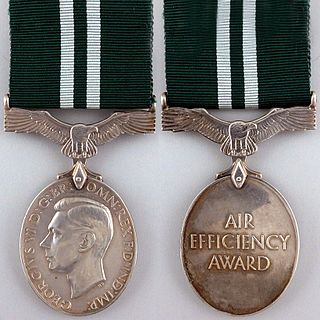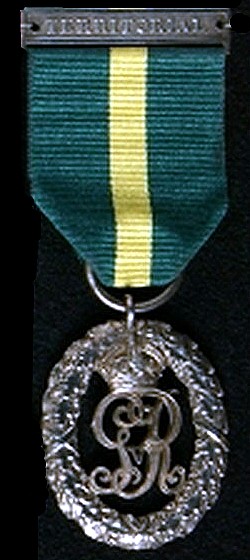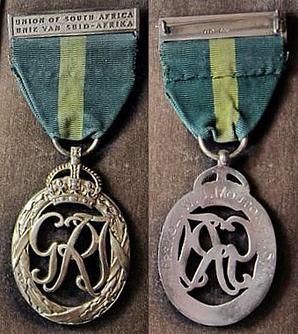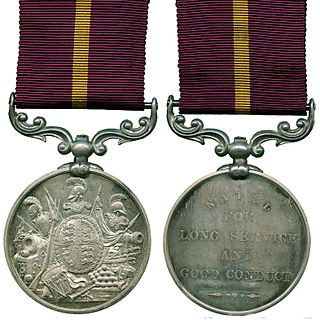
The Africa Service Medal is a South African campaign medal for service during the Second World War, awarded to members of the Union Defence Forces, the South African Police and the South African Railways Police. The medal was originally intended for service in Africa, but it was later extended to cover service anywhere in the world.

The Air Efficiency Award, post-nominal letters AE for officers, was instituted in 1942. It could be awarded after ten years of meritorious service to officers, airmen and airwomen in the Auxiliary and Volunteer Air Forces of the United Kingdom and the Territorial Air Forces and Air Force Reserves of the Dominions, the Indian Empire, Burma, the Colonies and Protectorates.

The Permanent Force Good Service Medal was instituted by the Republic of South Africa in 1961, when South Africa became a republic, to replace the Union Medal. It was awarded to Permanent Force members of the South African Defence Force for eighteen years of service and good conduct.

The John Chard Decoration, post-nominal letters JCD, was a military long service decoration which was instituted by the Union of South Africa on 6 April 1952. It was awarded to members of the Citizen Force of the South African Defence Force for twenty years of efficient service and good conduct. Clasps could be awarded after thirty and forty years service respectively.

The King's South Africa Medal is a British campaign medal awarded to all British and Colonial military personnel who served in the Second Boer War in South Africa, and who were in the theatre on or after 1 January 1902 and who had completed 18 months service in the conflict prior to 1 June 1902.

The Decoration for Officers of the Royal Naval Volunteer Reserve, post-nominal letters VD until c. 1947 and VRD thereafter, was instituted in 1908. It could be awarded to part-time commissioned officers in the United Kingdom's Royal Naval Volunteer Reserve after twenty years of service as efficient and thoroughly capable officers. The decoration was a Naval version of the Volunteer Officers' Decoration and its successor, the Territorial Decoration.

The Efficiency Decoration, post-nominal letters TD for recipients serving in the Territorial Army of the United Kingdom or ED for those serving in the Auxiliary Military Forces, was instituted in 1930 for award to part-time officers after twenty years of service as an efficient and thoroughly capable officer. The decoration superseded the Volunteer Officers' Decoration, the Colonial Auxiliary Forces Officers' Decoration and the Territorial Decoration.

The Efficiency Decoration (South Africa), post-nominal letters ED, was instituted in 1930 for award to efficient and thoroughly capable part-time officers in the Citizen Force of the Union of South Africa after twenty years of service. The decoration superseded the Colonial Auxiliary Forces Officers' Decoration.

The Efficiency Medal (South Africa) was instituted in 1930 for award to part-time warrant officers, non-commissioned officers and men after twelve years of efficient service on the active list of the Citizen Force of the Union of South Africa. At the same time, a clasp was instituted for award to holders of the medal upon completion of further periods of six years of efficient service. The medal superseded the Colonial Auxiliary Forces Long Service Medal.

The John Chard Medal is a military long service medal which was instituted by the Union of South Africa on 6 April 1952. Until 1986, it was awarded to members of the Citizen Force of the South African Defence Force for twelve years of efficient service and good conduct. The period of qualifying service was reduced to ten years in 1986.

The Union of South Africa Commemoration Medal is a military and civil commemorative medal which was awarded to commemorate the opening of the first Union Parliament by the Duke of Connaught and Strathearn in 1910. It may be considered as the first of many independence medals which were instituted throughout the Commonwealth during the 20th century.

The Permanent Forces of the Empire Beyond the Seas Medal is a long service and good conduct medal, instituted for award to other ranks of the Permanent Forces of the Dominions and Colonies of the British Empire. The medal, also known as the Permanent Overseas Forces Long Service and Good Conduct Medal, was established in 1910 as a single common award to supersede the several local versions of the Army Long Service and Good Conduct Medal which were being awarded by the various territories.

The Union Medal was instituted by the Union of South Africa in 1952. It was awarded to Permanent Force members of the South African Defence Force for eighteen years of service and good conduct.

The Medal for Long Service and Good Conduct (South Africa) (Medalje vir Langdurige Diens en Goeie Gedrag) is a distinctive South African version of the British Medal for Long Service and Good Conduct (Military). It was awarded to members of the Permanent Force of the Union of South Africa who had completed eighteen years of reckonable service.

In 1895, Queen Victoria authorised Colonial governments to adopt various British military decorations and medals and to award them to their local military forces. The Colony of Natal introduced this system in August 1895 and, in 1897, instituted the Distinguished Conduct Medal (Natal), post-nominal letters DCM.

In May 1895, Queen Victoria authorised Colonial governments to adopt various British military medals and to award them to their local military forces. The Cape of Good Hope introduced this system in September 1895 and, in 1896, instituted the Army Long Service and Good Conduct Medal (Cape of Good Hope).

In May 1895, Queen Victoria authorised Colonial governments to adopt various British military medals and to award them to their local military forces. The Colony of Natal introduced this system in August 1895 and, in 1897, instituted the Army Long Service and Good Conduct Medal (Natal).

In May 1895, Queen Victoria authorised Colonial governments to adopt various British military medals and to award them to members of their local permanent military forces. The Cape of Good Hope introduced this system in September 1895 and, in 1896, instituted the Meritorious Service Medal (Cape of Good Hope).

In May 1895, Queen Victoria authorised Colonial governments to adopt various British military medals and to award them to members of their local permanent military forces. The Colony of Natal introduced this system in August 1895 and, in 1897, instituted the Meritorious Service Medal (Natal).

In May 1895, Queen Victoria authorised Colonial governments to adopt various British military medals and to award them to their local permanent military forces. The Cape of Good Hope and Colony of Natal instituted their own territorial versions of the Meritorious Service Medal in terms of this authority. These two medals remained in use in the respective territories until after the establishment of the Union of South Africa in 1910.




















